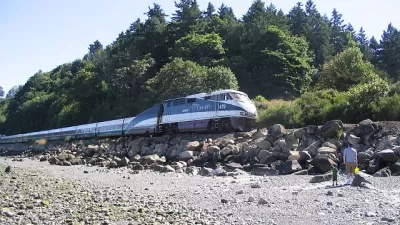The crash in Cayce, South Carolina on Sunday killed the engineer and conductor riding in the Amtrak locomotive, injuring over 100 passengers and crew members. A locked switch had directed Amtrak #91 into a siding where it hit a parked CSX train.
Amtrak Train 91, carrying about 139 passengers and eight crew members, left Boston shortly after 6 AM on Saturday, Feb. 3, headed for Miami. Soon after departing the Columbia, South Carolina station early Sunday morning (see schedule [pdf] for Silver Service / Palmetto route), the train left the one-track mainline and entered the siding where it hit the parked CSX freight train at around 2:35 a.m. ET, Feb. 4, near Cayce (pronounced CAY-cee).
"National Transportation Safety Board (NTSB) chairman Robert Sumwalt said Sunday that human error played a role in the train wreck," reports Sammy Fretwell for The State on Feb. 5.
CSX, as owner of the track, was responsible for making sure the track switch was in the right position. But Sumwalt said it was locked in the wrong position, which sent the Amtrak train off course.
He told reporters the accident “was indeed a tragic human error.’’
CSX says it does not dispute the facts in the case so far.
"The Lexington County coroner, Margaret Fisher, identified the dead as Amtrak employees: the train’s 54-year-old engineer, Michael Kempf, of Savannah, Ga., and a conductor, Michael Cella, 36, of Orange Park, Fla.," report Alan Blinder, Christina Caron and John Jeter for The New York Times. The freight train was reported to have been unoccupied at the time.
“The key to this investigation is learning why that switch was lined that way because the expectation was, of course, that the Amtrak train would be operating like this,” [Sumwalt] said, pointing to a whiteboard showing the passenger train’s southbound direction.
Federal Railroad Administration statistics have shown that in recent years the agency has had an average of about two derailments a month, accounting for about one-quarter of the accidents it reports.
As is the custom after passenger train crashes and derailments, talk turns to positive train control (PTC), a wireless technology utilizing GPS which may have been present on the locomotive and the track, but wasn't operational.
"Even though it is early in the investigation, Sumwalt was adamant about the benefits of positive train control, and how it could have factored into an incident like Sunday’s," reported Lori Aratani and Faiz Siddiqui for The Washington Post on Feb. 4.
“An operational PTC system is designed to prevent this type of accident,” he said. “A fully operational positive train control system could have avoided this accident, and that’s what it was designed to do."
The derailment comes less than a week after a chartered Amtrak train carrying GOP congress members to their West Virginia retreat on Jan. 31 slammed into a trash truck at a rural grade crossing near Crozet, Virginia, killing one occupant of the truck and injuring two others. On Dec. 18, Amtrak train 501 left the new Tacoma, Wash. station on its maiden voyage on the new, bypass route to Portland when it derailed over Interstate 5 near DuPont, Wash., killing three passengers, injuring over 100.
FULL STORY: Fatal train crash puts spotlight on CSX railroad crew

Maui's Vacation Rental Debate Turns Ugly
Verbal attacks, misinformation campaigns and fistfights plague a high-stakes debate to convert thousands of vacation rentals into long-term housing.

Planetizen Federal Action Tracker
A weekly monitor of how Trump’s orders and actions are impacting planners and planning in America.

In Urban Planning, AI Prompting Could be the New Design Thinking
Creativity has long been key to great urban design. What if we see AI as our new creative partner?

King County Supportive Housing Program Offers Hope for Unhoused Residents
The county is taking a ‘Housing First’ approach that prioritizes getting people into housing, then offering wraparound supportive services.

Researchers Use AI to Get Clearer Picture of US Housing
Analysts are using artificial intelligence to supercharge their research by allowing them to comb through data faster. Though these AI tools can be error prone, they save time and housing researchers are optimistic about the future.

Making Shared Micromobility More Inclusive
Cities and shared mobility system operators can do more to include people with disabilities in planning and operations, per a new report.
Urban Design for Planners 1: Software Tools
This six-course series explores essential urban design concepts using open source software and equips planners with the tools they need to participate fully in the urban design process.
Planning for Universal Design
Learn the tools for implementing Universal Design in planning regulations.
planning NEXT
Appalachian Highlands Housing Partners
Gallatin County Department of Planning & Community Development
Mpact (founded as Rail~Volution)
City of Camden Redevelopment Agency
City of Astoria
City of Portland
City of Laramie



























